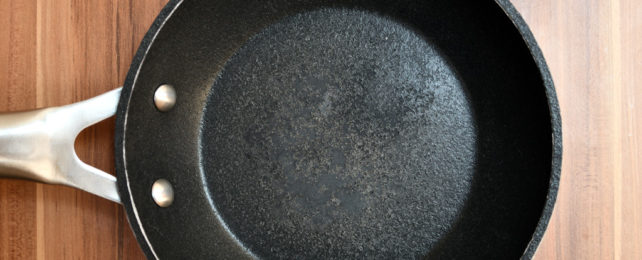A new study reveals just how many tiny plastic particles might be seeping into our foods after contact with cooking utensils, with a small broken crack on a Teflon-coated pan potentially releasing as many as 9,100 particles.
Non-stick pots and pans covered with Teflon gradually lose their coating as we use and wash them, which could be a problem during meal preparation. However, gauging just how much plastic is released is difficult.
The new research looks at microplastics (smaller than 5 millimeters or 0.2 inches) and nanoplastics (millions of times smaller still), concluding that we might be dealing with a substantial number of plastic fragments over time.
"It gives us a strong warning that we must be careful about selecting and using cooking utensils to avoid food contamination," says Youhong Tang, a mechanical and material engineer from Flinders University in Australia.
In an attempt to assess the risk, the team used what's known as a Raman imaging technique to study the microplastics and nanoplastics on a Teflon coating at a molecular level via photon scattering. They also applied bespoke algorithms to calculate how much of this coating might come unstuck and find its way into food.
The researchers cut the Teflon-coated cookware into small pieces and, to simulate the cooking process (albeit a cooking process without food, water, or oil), moved turners of different materials (stainless steel, wool, plastic, and wood) against the cookware in cooking-like fashions for a set amount of time.
A broken coating could cause as many as 2.3 million tiny particles to be released during meal preparation, according to the numbers – that's based on 30 seconds of cooking time if a cooking turner has ruptured a Teflon surface.
To add to the concern, Teflon (or polytetrafluoroethylene) is in the family of what are known as 'forever chemicals' that stick around in the environment: the per- and polyfluoroalkyl substances (PFAS) that have been linked to a variety of health issues.
"Given the fact PFAS is a big concern, these Teflon microparticles in our food might be a health concern," says Cheng Fang, a materials scientist at the University of Newcastle in Australia.
While there are still questions about just how common and dangerous this release of microplastics and nanoplastics might be, the researchers are calling for further investigation into the possible contamination effects during cooking.
It might be that older cooking pots and pans should be put out of use after a certain time or that Teflon coatings could be made more resistant to the wear and tear they go through while being washed and used.
Despite the impressive work, the research team acknowledges the difficulty in measuring and assessing plastic particles at these sorts of microscopic sizes. This area could potentially be improved in the future.
"More research is recommended to address the risk assessment of the Teflon microplastics and nanoplastics, given that Teflon is a family member of PFAS," says Tang.
The research has been published in Science of The Total Environment.
